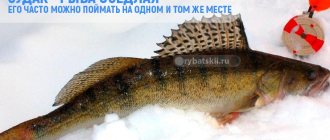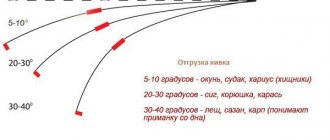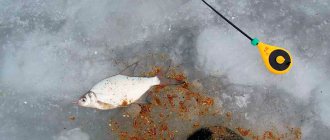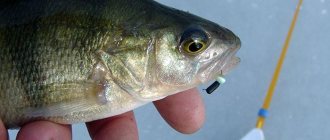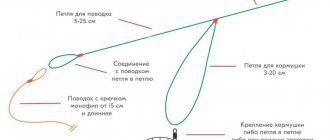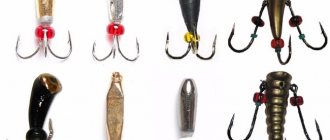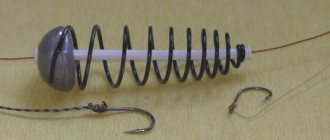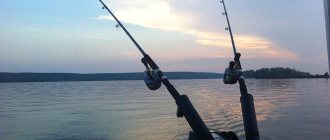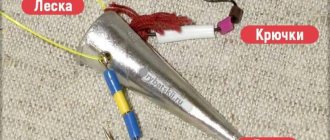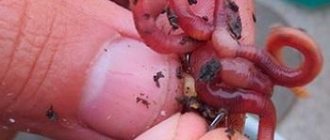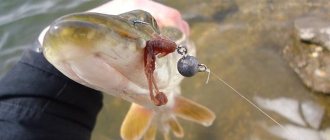In baitless gear, the rewinder nod is a fundamental component of the equipment. This part of the fishing rod is directly involved in creating the correct jig game. Depending on the length, configuration, and material of manufacture, it is possible to create one or another type of game with a reelless jig. Fine-tuning this element of the tackle, correct selection for the weight of the jig is the basis of working reelless equipment. In this article we will look at how to choose the right nod for a reelless bait, what options to use to obtain certain types of game with baits of different weights.
Mothless
Reelless gear is equipped taking into account both the fishing conditions and the angler’s habits. Each baitless player develops his own specifics of the game, adjusting the baitless gear to suit himself. Therefore, specific best nods for the mothless do not exist. Different anglers in different fishing conditions like completely different models - that’s why there are so many design and manufacturing options. A guard is not needed only in a nodless fishing rod. Regardless of the configuration and material, a good nod for a rewinder must meet the following requirements:
- Match the weight of the bait.
- Make the desired play of the reelless jig, frequency, amplitude.
- Visibility against the background of white ice, resistance to deformation in the cold, parasitic vibrations in the wind.
- Correspond to the type of fish being hunted, make oscillations of the required frequency and amplitude (fast, high-frequency or, conversely, smooth).
- Naturally, rough nipple guards (made of silicone tubes) and spring guards are not suitable for a rewinder. You will need a neat miniature plate made of suitable material.
What does a winter fishing rod consist of?
Both options, a fishing rod for fishing with a jig and a fishing rod for fishing with bulky lures, are somewhat similar, but at the same time there are slight differences between them.
A winter fishing rod for jig fishing most often consists of the following components: a reel or reel (both options serve as a handle), a pole and a nod. Additions are possible, but this is the classic version.
In the photo: an example of a classic winter balalaika fishing rod.
A winter fishing rod for fishing with bulky baits is equipped with different “ingredients”, the set of which depends on the fishing method: fishing with light or heavy baits.
Read How to make bait for fishing at home
In the first case, the fishing rod consists of a fishing rod, which acts as a handle, a reel, a whip and a nod. Moreover, if you use a flexible whip, you don’t need to use a nod.
In the photo: an example of a classic winter fishing rod, filly.
In the second case, when you go fishing with heavy baits, you will need serious, durable tackle, which, when animated, places higher demands on strength and rigidity than tackle for fishing with a jig. Such fishing rods are equipped with a short form, with several guide rings, including a tulip, and a handle on which either a spinning or multiplier reel is attached.
In the photo: an example of a winter fishing rod with an inertial reel.
Varieties
Unwinding nods can be:
- Short or long.
- Hard, soft.
- Straight, bent down (positive bend), backward curved (negative), s-shaped. This factor is chosen by the fisherman out of habit or convenience. Some forms (plastic, lavsan) allow you to change the bend, others (carbon) retain their shape.
- Various manufacturing materials: lavsan, plastic, metal.
A short, hard nod of the reeler will be needed to create a high-frequency game with heavy baits, a long one – for smooth, slow oscillations on bream. However, for high-frequency play with small jigs you need a long guard - and the majority of such jigs are like this. Here begins an endless fermentation among many options. Some nods are conditionally universal - with the proper skill, they can be used to create high- and low-frequency play. Others are specific, tailored for a specific jig, a certain type of game.
Experience will tell you which bait to choose for fishing with a reelless bait. To begin with, it is better to use simple universal options - lavsan, swallow wing, clock spring guards. It is impossible to say which nod is better for a reelless bait, apart from the habits of a particular angler, knowledge of the weight of the bait, and the method of play. Article about reelless winter fishing
Taper and test
The nods used in the rewinder are straight and conical. Straight is a strip of material of the same thickness and width throughout its entire length. Conical plates decrease in width towards the end, and double-cone plates also decrease in thickness. This imposes differences on the characteristics. Double-cone nods have a fast action - only the upper third is used when playing. Accordingly, this is the best option for high-frequency, fast gaming.
Straight guards bend evenly under load - this option is more suitable for creating a smooth and slow bream retrieve. A short nod cannot force a heavy reelless reel to play slowly and smoothly. However, these are not all the variables. The rigidity of the nod of the rewinder depends on the length of the plate and the properties of the material of manufacture. Metal has inertia, lavsan is soft, carbon always returns to its starting point.
A conical or double-cone nod requires precise adjustment to the weight of the jig, and is ground down manually with sandpaper in each equipment option. Selecting a nod for a rewinder is an age-old question for nozzle-less fishermen. You should focus on personal preferences and the ability to play with a jig. Only with practice will it become clear whether this particular option is suitable for a particular tackle. In this matter, constant experimentation and improvement is important.
Some manufacturers indicate the jig test (weight of the jig) for which it is intended. For a beginner, such store-bought solutions eliminate some of the issues. However, it often becomes clear over time that this option is not suitable for other tasks (a different game, greater depth). You have to buy a new one and look for other solutions. Experienced mothless workers often make mothless guards for themselves on their own.
Operating principle, resonance phenomenon
It is difficult to create a monotonous high-frequency game with a short nod; this requires a fairly well-trained hand in such wiring. With a fishing rod it is necessary to create vibrations of the same small amplitude at the required speed without failures. It is easier to do this with a long guard, since due to vibration, the large amplitude of vibration of the fishing rod (which is easier for a person simply anatomically) is converted into a small one, and the frequency remains the same.
However, for this, the long blank must be correct, have certain rigidity indicators, and correspond to the weight of the reelless machine. Therefore, the long version is often used for baitless baits - it is easier for them to create a high-frequency game without failures. At the same time, the arc for cutting increases, accordingly, it needs to be done more sharply, sweepingly than with a short guard (in order to have time to pick up the slack).
A - amplitude of the fishing rod A2 - amplitude of the action of the jig
Due to this phenomenon, craftsmen create forms that have a vibration frequency of the tip several times greater than the movements of the fishing rod that produce them. During one swing of the whip, the working part of such a guard produces several oscillations of equal amplitude (not to be confused with manifestations of inertia). This phenomenon is called resonance. To obtain a resonant nod, weights are hung on it in various places. Such weights are called resonators. These can be lead weights, beads, wire rings placed on a form. Getting the resonance right will take time and experimentation. The resonators are shifted or changed in weight until the guard produces the desired frequency an order of magnitude higher than that of the whip when oscillating.
How to choose a nod for a winter fishing rod?
The correct selection of tackle, taking into account its weight, size and peculiarity of the game, is of paramount importance in choosing a nod.
- Nods for fishing with reelless baits. When fishing under the ice with a jig that does not have an attachment, an incorrectly configured guard will leave the fisherman without a catch. In this case, you need a uniform and monotonous play of the jig with stable operation of the nod. To do this, the hole located at the end of the nod must be slightly larger than the diameter of the fishing line, otherwise the tackle will be uncontrollable. The line must be passed through the cambric, put on the working part of the nod, otherwise the arc of the line above the nod will dangle and the play of the bait will be unstable. Nods for winter fishing rods are made from lavsan or thin sheet plastic, resulting in the softest guards. They catch small fish: roach and perch.
- Nods for jig fishing should be more universal. When using a light jig, its length decreases, and when using a heavy jig, it increases. The guard is adjusted so that it transmits the vibrations of the fishing rod to the jig, and at the same time has rigidity.
- Nods for vertical trolling should be made of dense fishing line and have a short length. The guard does not have any influence on the game of the bait; it only determines the perfect bite. Suitable for fishing for large perch.
- The nods for the balancer depend on the mass of the latter. The guard should clearly indicate the beginning of the bite and the contact of the balancer with the bottom surface. A silicone or lavsan guard with a length of 4 to 7 cm is well suited. A thin twisted spring is often used to make it. It is attached to the whip with a movable mount, so you can quickly change the length and stiffness. Such nods for a winter fishing rod are designed for catching large predators with a spoon.
Read How to catch bream on a feeder and prepare the equipment
Lavsan
Most often, the lavsan nod is found on the rewinder due to its prevalence and ease of processing. At the initial level, you can choose this element of tackle in a fishing store, selecting it for the weight of the jig. It is better to purchase a slightly harder one than necessary, and then grind it down to a cone with sandpaper until it is acceptable. The hole in the tip of the plate widens slightly and is processed to remove burrs. You can repeat store-bought preparations yourself if you have the materials - lavsan, caprolavsan, astralon. In general, being a nozzle-less person, you need to get into the habit of looking closely at any similar materials you come across, checking their suitability.
Lavsan with spring
A homemade guard for a nozzle is carefully cut along a ruler with a stationery knife. Then holes are punched in the workpiece (with a needle, drill), and the connector is attached. After this, the form is adjusted using sandpaper to the desired weight of the rewinder. The properties will also depend on the degree of rigidity of the material (thickness of the lavsan) and the length of the workpiece. It is established experimentally what length and width the workpiece should be (according to the weight of the reelless, the frequency of play).
The desired bend can be given to a lavsan guard for a nozzle by passing it through a nail under load. Among the store-bought ready-made options, nozzle-less specialists on the forums recommend special nods for the Levsha-NN rewinder, conical, double-cone, with an indication of the test. However, with due attention, it is not difficult to sharpen any lavsan blank to the desired state.
Other options
Mothless workers also use metal nods. A standard guard from a store with a large ring at the end will not work - metal has strong inertia, a heavy ring will only intensify this phenomenon. Mothless workers use neat, thin guards made of titanium, steel, single crystal copper and other alloys. Options:
- Sports nods made of steel.
- Spring (any materials).
- Nod made of copper monocrystal Mosquito Nose.
- Nod Swallowtail.
- Various metal gatehouses made of bronze, beryllium alloys and copper.
- Carbon.
The spring nod is assembled from several plates (metal, lavsan, etc.). The result is the same fast tuning for high-frequency playing - only the top third is involved in the game. This guard is adjusted by moving the plates. Combined gatehouses consist of plates of various materials, for example, steel and lavsan.
Spring principle
The swallowtail wing (dovetail) tapers towards the end unevenly, but in a hyperbole. Thus, with a light jig, only the top works, and with a heavy jig, the entire form works.
Swallow's wing
A carbon nod is made from a split carbon fiber rod. This procedure is complex and tedious - one wrong move will destroy the workpiece. The principle is the same - a strip is selected from a split fishing rod and the form is cut to the required length. Then the form is carefully ground into a cone using sandpaper for a specific stencil. The carbon fiber nod is made for one weight and a specific game - it will be impossible to remake it for other options.
Experienced nozzle-less users who use such solutions claim that this is the best option for a no-rewinder. Such a guard has absolutely no memory or inertia and always returns to its original position. When tightening the fishing rod, it folds into a figure eight and then straightens out again. However, for each reelless jig and type of fish you need a separate nod.
Properties of carbon
For a novice mower, it is important to avoid making a common mistake. You shouldn’t look for a super catchy option - there are no such things. Everyone needs their own approach. It is important not to look for a model, but to learn how to use a specific jig, find an approach to it, correctly adjust it to your gear (more on this later), the style of play, and the weight of the reelless jig. Various swallowtails and mosquito noses are an expensive pleasure.
It is not at all a fact that after such an acquisition the tackle will become catchable. You also need to know how to use such gatehouses. It’s easier to start with lavsan or other easy-to-make homemade products, gradually increasing your experience in this matter, supplementing the gear with new guards, as part of the experiment.
Bottom fishing rod guard
Almost all fishing gear has bite alarms: floats, nods (guards), bells, bells, and so on. Their work is very simple and useful: a fish swims up, grabs the bait, tries to leave this place, and the guard begins to twitch and ring. Its main function is to warn the fisherman that it is time to hook an aquatic creature. The nod is placed on feeder rods, bottom and other gear.
Homemade combination nod
- Specifics of nods and their types
- We make a simple signaling device for a donut from a cable tie
- Manufacturing of adjustable nods
- Using non-flexible material
- From old fountain pens
- Conclusion
- soft nods,
- intermediate (medium hardness),
- hard alarms,
- heavy guards.
Homemade mothless gatehouses
Most nozzle-free operators make their own nods for the rewinder. Suitable store-bought options are expensive, but cheap ones are not suitable. The advantage of such a homemade nod for a reelless fish is that it is initially made by the fisherman “for himself,” taking into account all the requirements and habits in the game. Manufacturing materials:
- Sheet plastics - vinyl, polycarbonate, lavsan, caprolavsan, astralon, bottle scraps. Any PET and its thermoplastic derivatives (polyethylene glycol terephthalate).
- X-ray film.
- Boar bristles.
- Clock spring.
- Carbon from a fishing rod (with skill and patience).
To make it you will need a metal ruler and a stationery knife (scalpel) for cutting, an awl, needles, cambrics and wire insulation, needle files and sandpaper. The principle is the same - a blank (and springs) of the required length and shape are cut out of the material, then the workpiece is adjusted using sandpaper and a file to match the weight of the rewinder. For a moth-eater, “nodding search” is a normal phenomenon. Before finding out and defining that very treasured gatehouse for yourself, you have to try dozens of different design options and materials.
The most popular material is lavsan of various thicknesses. Depending on the selection of the thickness of the lavsan and the length of the form, different rigidity is obtained. Sanding to a cone (one or two) will give the desired properties. It didn’t work out - we try again, make the length with a margin - you can always trim off the excess. The main form can be sprung with additional strips (if desired, make a soft tip with a hard butt). After turning the blank, all that remains is to punch holes, paint it, and attach it to the fishing rod with a connector (cambrics).
From a plastic bottle
Plastic bottle nods are made using the same principle. Before the result is achieved, a lot of material will most likely be spoiled. However, with due patience, it turns out to be an excellent guardhouse for the mothless moth. For a guard made from a plastic bottle, any water, beer or lemonade container with smooth sides is suitable. The cut out part of the bottle is straightened by heating it with an iron through a rag.
To make a homemade nod for a winter fishing rod, a form of the required length is cut out of a bottle using the standard method (with a ruler and a knife) and processed. This option is suitable for bloodworm fishing. For rewinding, bottle plastic is subjected to heat treatment - only then is the necessary elasticity achieved. To do this, the workpiece is heated over a heat source (stove, gas) and slightly stretched to the sides with two pliers. This is a delicate point - the plastic must not be overheated, otherwise it will curl.
At the same time, you cannot overtighten the workpiece. Stretching is carried out approximately by one-fifth of the length of the workpiece. This skill will come after several spoiled blanks. After stretching, the form is removed from the heat and held in the same position for some time (until it cools). Then - further according to the scheme, sanding and equipment for the rewinder. This type of guard works better in the long version for heavy moths.
X-ray film
For light mothless insects, a nod made of X-ray film is suitable. You can simply cut it out of film in one layer - suitable for light rewinders at shallow depths. A more universal option is a nod made of X-ray film with stiffeners. To do this, when cutting the workpiece, the width of the material for these ribs is also taken into account. The folds are made using a fountain pen with pressure. When cutting and punching, the taper is taken into account. After cutting, the stiffeners are folded inward and the workpiece is aligned with the nail. It turns out to be a fast-moving guardhouse. Next - according to the diagram. Instead of stiffeners, you can make springs from the same film. You will get a spring nod - it’s easier for everyone.
1. Punching edge edges and cutting
Pressing the ribs
3. We get a fast system
Homemade metal gatehouse
How to make a nod from a watch spring? On the same principle as plastic gatehouses. The required length of the spring of a men's wristwatch is cut off (on women's the strip is too narrow), and then ground down onto a cone evenly on all sides. This is the main difficulty - excess metal cannot be easily removed, like from lavsan. The nod blank from the clock spring must be clamped in a vice and ground down with a file (diamond whetstone). At the same time, it is important not to sand off excess. You need to sweat, but the result will be a beautiful do-it-yourself watch spring nod. Further according to the plan - fastenings, cambrics, rings, finishing under the weight of the jig. Instead of a clock spring, you can experiment with a tape measure.
From a clock spring
From roulette
Boar bristles
The boar bristle nod has a great past. Previously, when there were no plastics, this was almost the only material for making gatehouses. Such a guard for a nozzle is also suitable, but it is much more difficult to make. You need to choose the right bristles, weave them, and wrap the ends so that they don’t unravel. A bristle nod works well, but is no better than plastic. There is no point in bothering with it now (well, only if for the sake of historical reconstruction). Making nods from boar bristles is a legend of bygone days. These guards require maintenance, they are fragile and cannot be adjusted, do not sharpen to a cone and are more suitable for bait fishing.
Gear for catching ripus
The “Flapper” nod for a winter fishing rod is successfully used when fishing for fish of the salmon family on northern lakes.
To make a fishing rod and nod you will need:
- rod "Dolphin";
- one-piece carbon fiber or carbon fiber whip;
- tulip;
- elastic band for attaching the nod;
- nod from a clock spring;
- silicone cambric;
- epoxy resin;
- pliers;
- needle file;
- fishing line;
- insulating tape.
- Remove the hangers from the tulip with pliers and clean it with a file. Raise his ring five degrees up.
- Measure the required length of the whip (everyone chooses for themselves) and cut it off. It is advisable that it be non-hollow, strip off the ends.
- From the whip of the finished fishing rod, cut off the lower part that is attached to the fishing rod, drill a hole in it and glue a new one there.
- Put an elastic band on the other end of the whip, insert and glue the tulip.
- Take a nod from a clock spring, put 2-3 pieces of cambric on it to support the fishing line and stick it into the elastic band, leaving a small tip for fastening. The nod should be several millimeters longer than the whip. Usually its length is 15 cm.
- Secure the tip of the nod after the elastic band with electrical tape.
- Wind the line onto the reel and insert the whip into the rod.
- Thread the fishing line into the elastic and cambrics on the nod. The result was a “Clapperboard” nod for a winter fishing rod.
The guard must be loaded correctly. To do this, use a weight of no more than 4 g.
Settings
We mean that after reading all of the above, the angler’s head is a mess. Let's summarize - in a reelless game, the main thing is not the guard itself, but its compliance with the jig and the necessary game. It doesn't matter what design is used. If the fish bites and is caught, it means that everything was done correctly, even if some points do not coincide with the theory. Loading the reelless nod is the final stage. We attach a jig to what came out of the blank, and adjust the guard to a specific reelless jig. How to choose a nod for a rewinder?
Without load
Loaded
When purchasing - using the test or directly hanging the required rewinder to it. There is no need to explain to experienced people how to choose a rewinder nod. For beginners, it’s better to torment the seller once again, ask for jigs of different weights, hang them up to determine the test (if one is not specified).
The final adjustment and adjustment of the nod for the reelless bait is done at home, directly with the jig that will be working on this fishing rod. The guard should not sag too much under the weight. Maximum – 20-30 degrees. When the nod is bent upward under load, it should bend down slightly, about ten degrees. A straight blank under load, accordingly, bends down a little lower. What is important here is not specific angle numbers, but the ability to reproduce the required game, amplitude and frequency of oscillations. It makes sense to practice in a bucket of water.
Setting options (dancing with a tambourine):
- Selection of working length (extension, trimming excess).
- Stitching onto a cone (or better yet, double).
- The spring lining is made of plates of the same material.
- Curve (if possible) upward or into an S-shape.
- Placement of resonators and experiments with them.
Coloring
Making a nod for a rewinder with your own hands also involves painting the workpiece. The main principle is contrast. This is especially true for white plastics - against the background of snow and ice, such guards are poorly visible. Thin strips of waterproof varnish are applied to the workpiece. You can just paint the whole thing. Good contrasting colors are black and red. The main thing is without fanaticism. You can’t apply a lot of varnish, it also has weight. Too thick a layer can throw off sensitive playing.
Connectors (holders)
When making a nod for a reelless reel, you need to think about the issue of attaching it to the tip of the fishing rod. To do this, you can pick up a special store-bought connector, or make it yourself from cambrics and pieces of wire insulation of different diameters. Two smaller ones are inserted into the widest cambric - for a fishing rod and fishing line. It’s even better to tighten two cambrics with heat shrink - it will be tighter. The installation is made in such a way that during the operation of the fishing rod these cambrics and pieces are held tightly and do not jump out.
The principle of a cambric connector
The simplest holder
The nod plate can be firmly fixed or with the ability to adjust the extension length. Each angler independently comes up with his own options - there is no consensus on this matter. The main thing is that it is convenient and does not interfere with the functionality of the reelless fishing rod.
Subscribe to the channel:
My YouTube channel RYBAFAN on fishing:
We're OK
I make such nods like this
From the middle of the bottle I cut a strip of the required width. Usually it is 5-6mm. I always cut along the bottle, but if you cut across, then such a nod with your own hands will work worse.
Using a heated needle, I burn two holes in the strip to allow the fishing line to pass through. A hole with a diameter of about a millimeter - one from the edge of the strip, the second closer to the middle.
